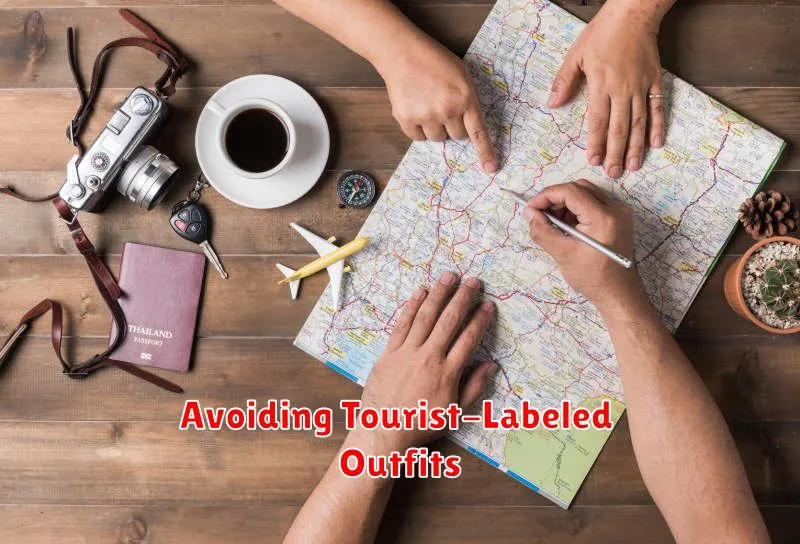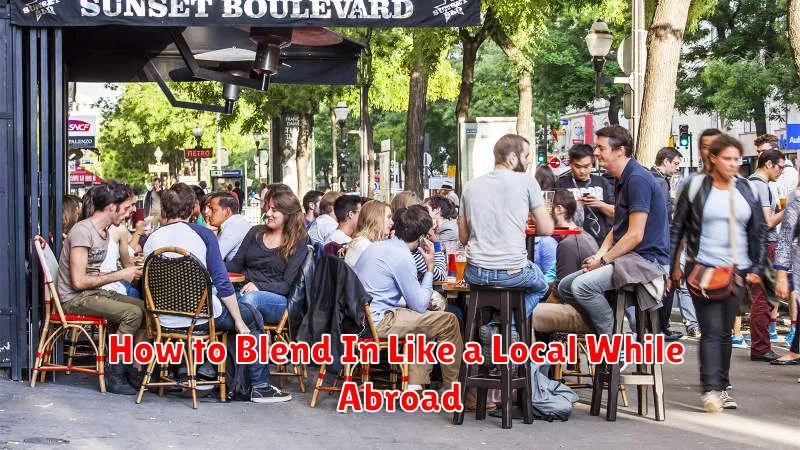Traveling to a new country offers the exciting opportunity to experience different cultures, customs, and ways of life. But sometimes, standing out as a tourist can detract from truly immersing yourself in the local experience. This article will explore practical tips and strategies on how to blend in like a local while abroad, allowing you to connect with the culture on a deeper level and gain a more authentic travel experience. Learn how to navigate new environments with confidence and respect, from understanding local etiquette to mastering public transportation like a seasoned resident. Whether you’re planning a short trip or an extended stay, mastering the art of blending in can enhance your journey significantly.
Blending in doesn’t mean erasing your identity, but rather adapting to the local customs and respecting cultural nuances. This guide will provide valuable insights into how to blend in like a local, covering essential aspects such as appropriate attire, local etiquette, and understanding cultural norms. Discover the secrets to navigating daily life abroad with ease, from ordering food in local restaurants to using public transport efficiently. By understanding the subtle cues and unspoken rules of a new environment, you can avoid common tourist pitfalls and embrace a more immersive and enriching travel experience. Learn how to truly connect with the heart of a place and its people by blending in while abroad and create unforgettable memories that go beyond the typical tourist experience.
Why Blending In Helps Stay Safe
Blending in with your surroundings can significantly increase your safety, especially when traveling or in unfamiliar environments. By avoiding behaviors or appearances that make you stand out, you reduce the chances of becoming a target for criminals who often look for individuals who appear vulnerable or unaware. Avoiding flashy jewelry, dressing like a local, and refraining from overt displays of wealth can deter unwanted attention and help you move through crowds unnoticed.
Understanding local customs and social norms is crucial for blending in effectively. Researching your destination beforehand can provide valuable insights into acceptable attire, behavior, and social interactions. This knowledge allows you to navigate new environments with confidence and avoid unintentional cultural faux pas that could draw unwanted scrutiny. Being aware of your surroundings and acting like you belong is a key aspect of personal safety.
In addition to personal safety, blending in can enhance your overall travel experience. By appearing less like a tourist, you are more likely to encounter authentic local interactions and gain a deeper understanding of the culture. Observing and respectfully mimicking local behaviors, such as modes of transportation or common greetings, can facilitate communication and foster positive relationships with the people you meet.
Avoiding Tourist-Labeled Outfits

Want to blend in more with locals and less like a target? One of the easiest ways is to ditch the stereotypical tourist uniform. Think twice about overly branded clothing, especially items plastered with logos of your home city or sports teams. Also, consider leaving behind items like fanny packs, visors, and hiking sandals worn outside of actual hiking activities. These items often scream “tourist,” which can make you more vulnerable to scams or petty theft.
Instead, opt for comfortable yet stylish clothing that you would typically wear at home. This might include neutral-colored tops and bottoms, a light jacket, and comfortable walking shoes. Dressing like a local shows respect for the culture and helps you integrate more seamlessly into your surroundings. Observe what people around you are wearing and subtly adapt your style accordingly.
Finally, remember that practicality is key. Consider the weather and activities you have planned. A small, cross-body bag is a safer and more stylish alternative to a fanny pack, while a baseball cap or wide-brimmed hat offers sun protection without the distinct tourist vibe of a visor. By making these simple changes, you can enjoy your trip with more confidence and blend in effortlessly.
Using Local Language Basics
Using the local language, even just a few basic phrases, can greatly enhance your travel experience. Greeting people in their native tongue demonstrates respect and can lead to more positive interactions. It can also be invaluable when navigating unfamiliar situations, such as asking for directions or ordering food. Even a simple “thank you” can go a long way in building rapport.
Learning key phrases like “hello,” “goodbye,” “please,” and “thank you” is a good starting point. Consider expanding your vocabulary to include phrases related to your specific needs, such as “excuse me,” “where is the bathroom?,” or “how much does this cost?”. Utilizing a phrasebook or language learning app can be immensely helpful. Don’t be afraid to practice what you learn – locals often appreciate the effort, even if your pronunciation isn’t perfect.
While mastering a new language isn’t necessary for a short trip, demonstrating a willingness to engage with the local culture through language can significantly enrich your experience. It can open doors to more authentic interactions and create lasting memories. Embrace the opportunity to connect with people on a deeper level by speaking even a few words of their language.
Following Public Behavior Norms
Following public behavior norms is essential for maintaining a peaceful and respectful society. These norms, often unspoken, dictate acceptable conduct in shared spaces. They vary across cultures, but generally encourage considerate behavior, such as queuing politely, keeping noise levels reasonable, and respecting personal space. Observing these norms ensures smoother social interactions and contributes to a positive communal environment.
Key aspects of public behavior norms include cleanliness and hygiene, proper attire, and respectful communication. Disposing of waste properly, avoiding littering, and maintaining personal hygiene demonstrates respect for shared spaces. Dressing appropriately for the context shows consideration for others. Using polite language, avoiding offensive language or gestures, and respecting differing viewpoints fosters positive interactions.
Ultimately, adherence to public behavior norms contributes to a harmonious society. By being mindful of our actions and their impact on others, we can create a more pleasant and respectful public sphere for everyone. This encompasses demonstrating empathy, being mindful of vulnerable individuals, and proactively assisting those in need when possible.
Navigating Without Looking Lost
Successful navigation hinges on a few key skills. First, situational awareness is crucial. Understand your current location, your destination, and the general layout of the surrounding area. This can be achieved by studying maps beforehand, paying attention to landmarks, and using a compass or GPS device.
Next, planning your route is essential. Consider the best path based on time, distance, and potential obstacles. If using a GPS, be mindful of its limitations and always have a backup plan in case of technical difficulties or unexpected detours. Regularly check your progress against your planned route to ensure you stay on track.
Finally, developing strong observational skills is vital. Notice street names, building numbers, and distinct features that can help you orient yourself. Don’t be afraid to ask for directions if needed, and remember to stay calm and focused if you do become disoriented. Recalling landmarks you’ve already passed can help you reorient yourself and find your way.
Being Discreet with Maps and Cameras
In unfamiliar environments, it’s natural to rely on maps and cameras. However, overt use of these tools can mark you as a tourist, potentially making you a target for scams or theft. Discreetly consulting your resources helps you blend in and maintain a low profile. Fold large maps into manageable sections, referring to them quickly and subtly. Avoid unfolding a large map in a crowded area. Instead, duck into a shop or less conspicuous location to orient yourself. Similarly, be mindful of how you use your camera. Rather than constantly snapping photos, take a moment to observe your surroundings and choose your shots carefully. This demonstrates respect for the local culture and minimizes unwanted attention.
When using a smartphone for navigation or photography, be aware of your surroundings. Avoid holding your phone up in vulnerable positions where it could be easily snatched. Consider using headphones connected to your phone for directional prompts, minimizing the need to look at the screen frequently. Lowering the screen brightness also reduces visibility and helps you blend in, especially at night. If possible, familiarize yourself with key routes and landmarks beforehand to lessen your reliance on technology in public spaces.
Ultimately, the key to being discreet is situational awareness. Pay attention to the people around you and adjust your behavior accordingly. If you feel uncomfortable in a particular area, trust your instincts and move to a safer location before consulting your map or taking photos. By being mindful and unobtrusive, you can enjoy your travels while minimizing potential risks.
Earning Local Respect
Building strong relationships within your local community hinges on respectful engagement. This involves actively listening to and valuing diverse perspectives, supporting local businesses and initiatives, and contributing positively to the overall well-being of the area. Being a good neighbor, participating in community events, and treating everyone with courtesy and kindness are essential steps.
Open communication plays a vital role. Engage in thoughtful conversations, be willing to learn from others, and offer assistance where you can. Demonstrating a genuine interest in the community and its members fosters trust and mutual understanding, which are crucial for building lasting connections and earning respect.
Finally, remember that earning local respect is an ongoing process, not a destination. It requires consistent effort, a willingness to adapt, and a genuine commitment to being a valuable member of the community. Over time, your positive contributions will be recognized and appreciated.

